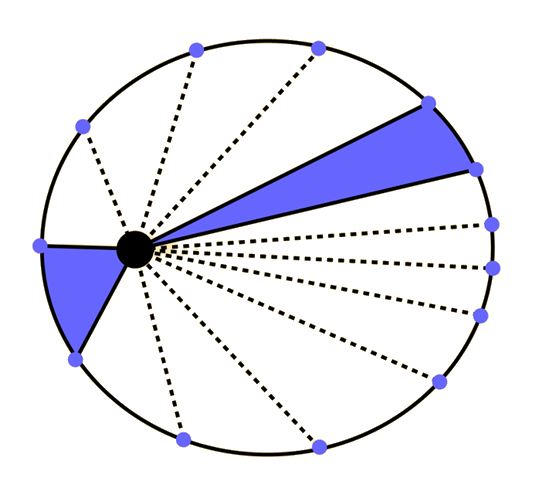In terms of the technical understanding of our local vicinity in the universe, we’ve advanced quite a bit since ye olde times. Through constant theorising, gathering data, and more theorising, we have gradually built a more foundationally solid picture of the universe we live in. However, even now in this period of technological prosperity, there is still so much we are yet to discover and harness, so much that has yet to be explored. Only by harnessing the power of hindsight (oh, what a wonderful thing) do we look back on scientists and astronomers alike, believing that they were complete madmen for thinking the things they thought. But do we really know any better?
My post today will be focusing on one specific astronomer, whose work revealed the true nature of our own solar system. This is none other than Johannes Kepler, whose laws are a major part of the foundation of modern astronomy and physics. Before the time of Kepler, at around 300 BC, philosophers like Aristotle and Ptolemy put forward arguments that the Earth was stationary and that all the other bodies in the solar system moved in circular orbits around them (geocentric). They held a firm belief that the Earth was for some mystical reason more important than anything else, and hence would probably be located at the centre of the universe. Typical Earth thinking it’s so special… The orbits of the other stars and planets around the Earth were thought to be perfectly circular, since this model would be most stable. These ideas constituted a complete cosmological model of the universe, and without further data to prove otherwise, it was generally accepted. This model, despite its flaws, actually worked pretty well in being able predict the positions of bodies in the sky.
Only a millennium later was a new model proposed by Polish mathematician and astronomer, Nicholas Copernicus, who had the idea that the Sun was in fact stationary at the center and that the Earth and other planets moved in orbits around the Sun (heliocentric). This idea, originally too outlandish for most scholars of his time to accept, slowly came into fruition through the support of two astronomers, Galileo Galilei and (our star guest) Johannes Kepler.
Kepler used data painstakingly gathered by Tycho Brahe, a Danish noble fascinated by astronomy, to produce three laws of planetary motion which describe the motion of planets around the Sun.
The first law, sometimes referred to as the Law of Orbits, explains that the planets orbit the Sun, not in a circular motion, but in an elliptic sweep. An ellipse is the path drawn by all points whose total distance to two focii (or ‘central points’) remains constant. You can draw one on paper fairly easily by using two pins, a piece of string, and a pencil. Stick the two pins into the paper a few centimetres apart, and wrap the string around them loosely. The pins will act as the focii. Then take your pencil and pull on the inside of the loop of string so that you form a triangle between the two pins and your pencil. Now, draw on the paper and pull your pencil around the outside of the pins, keeping the string taut. The resulting shape should look like a squashed circle. You can try repeating this process but with different distances between the pins, and observe what happens.
On the planetary scale, the Sun is acting as one of these focii. The elliptic shape of the orbit is a result of inverse square law of gravity, which essentially means that the gravitational force between the Sun and a planet becomes increasingly weaker, the further away that planet is.
Kepler’s second law is called the Law of Areas, which describes the speed at which planets orbit the Sun. From the conservation of angular momentum, the planets move at higher speeds the closer they are to the Sun, sweeping through a longer path during the same amount of time. If you imagine a line between the Sun and a planet, this law states that this line will sweep across equal areas in equal amounts of time, no matter where it is in the orbit.

The third and final law is known as the Law of Periods. This states that the period of a planet’s orbit squared is proportional to the cube of the semimajor axis of its orbit (the distance from the planet to the centre of the ellipse, between the two focii, when the planet is at the long end of the ellipse, kinda like a long radius). So what can we learn from this? It tells us that the planets in our solar system obey some common rules. If we know the size of the orbit of a planet, we can figure out how long it will take to go around the Sun. For example, the Earth takes 1 year to go around the Sun, and it is 1 astronomical unit (AU) from the Sun. If we hypothesised a planet at 4 AU, it would take the planet 8 years to orbit the Sun once. However, this equation is only useful for our own solar system. Isaac Newton was able to derive a more general form based on his laws of gravitation, which I may talk about in future posts.
What I want you to take from this post is the fact that we, as scientists, are constantly revising and reconsidering everything we believe to be true, because there are always things we may not be able to see from where we currently are. Persevere, and you will uncover more and more about our fascinating universe. There’s a delightful quote from the beginning of A Brief History of Time by Stephen Hawking that I just love, and I feel like it fits here quite nicely. If you haven’t read the book already, I do urge you politely to do so.
A well-known scientist (some say it was Bertrand Russell) once gave a public lecture on astronomy. He described how the earth orbits around the sun and how the sun, in turn, orbits around the center of a vast collection of stars called our galaxy. At the end of the lecture, a little old lady at the back of the room got up and said: “What you have told us is rubbish. The world is really a flat plate supported on the back of a giant tortoise.” The scientist gave a superior smile before replying, “What is the tortoise standing on?” “You’re very clever, young man, very clever,” said the old lady, “But it’s turtles all the way down!”
Harvey

Even though my brain frazzed out when it got to the sentence about the law of periods, this is very interesting.
LikeLiked by 1 person
Thank you!
~Harvey
LikeLiked by 1 person
In my Ethics course, we spoke about Aristotle and the ethical dimensions of the geocentric model he believed. It’s always nice to see what I’m learning reflected in these other places and spaces. Every lining up so neatly…it makes me happy.
Additionally, it’s really just cool to learn something new and amazing every time I read your blog. Thanks.
LikeLiked by 1 person
Thank you. I’m glad you enjoyed the post! I also love being able to join the dots together between different disciplines.
~Harvey
LikeLike
This post was very informative, well detailed and very interesting.
LikeLiked by 1 person
Thank you very much!
~Harvey
LikeLike